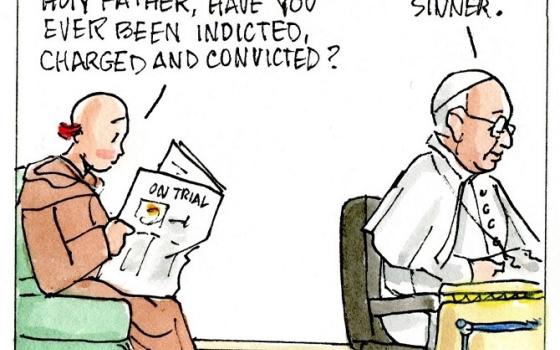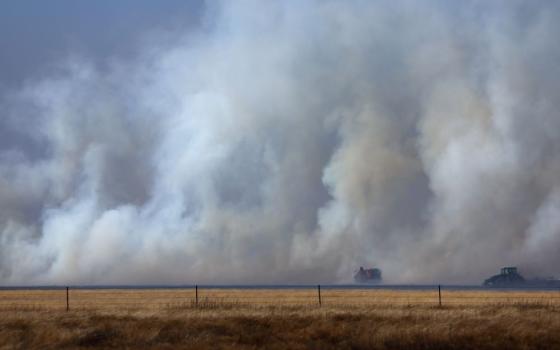
Uprisings in the Arab world, the embassy killings in Benghazi, Libya, and the possibility of a nuclear-armed Iran were talked about in the sparring matches between the presidential candidates last month, but little mention was made by either candidate of the fastest-growing and, in many respects, most controversial element of U.S. foreign policy.
The use of armed drones, unmanned aircraft, to hunt down individuals and groups far beyond any established battlefields or war zones has exploded under the Obama administration. In their foreign policy debate Oct. 22, President Barack Obama and challenger Gov. Mitt Romney made one passing reference to drones. There was no debate. They agreed on the addition of drones to the U.S. arsenal and on the manner in which they are being used.
Each expansion of drone use magnifies the concerns of the legal and human rights communities about whether the United States is dangerously pressing the limits of -- or even violating -- international law. Just as worrisome, experts say, is whether the increasing use of drones in such circumstances will slowly erode the force of international law, rendering it ineffective.
Pressure for more drones came in a recent CIA request for "a significant expansion of the agency's fleet," according to a Washington Post report. The request, said the report, could add as many as 10 more drones to the fleet of 35 that is gradually transforming the CIA into a military force of its own.
"Targeted attacks" by drones within countries not openly at war with the United States -- and even in some that are considered allies -- also raise thorny questions about the evolving nature of war and how it is conducted.
The dimensions of the problem are outlined in the opening paragraph of an essay by Kenneth Anderson for a national security task force of the Hoover Institution. "Targeted killing using armed drones," he writes, "has raised profound anxieties in legal, policy, and advocacy communities in the United States and abroad, including among U.N. officials and special rapporteurs, high-ranking diplomats and lawyers of foreign and defense ministries of important states and allies, civil liberties and human rights advocacy groups such as the American Civil Liberties Union, and important commentators in academic international law and the press and media."
At the same time, Anderson writes, "Others are equally adamant that targeted killing using drone technology is a significant step toward making conflict less harmful to civilians and more discriminating in its objectives." Even those who might otherwise be opposed to drone use were taking a new look at the issue when the U.S. introduced the unmanned craft in support of the uprising in Libya, he wrote, and they discovered that drones "have irresistible attractions in a war of humanitarian intervention."
Efficiency not the point
Whether drones may be an efficient tool of war is beside the point for Mary Ellen O'Connell, a University of Notre Dame Law School professor and an ardent critic of the use of drones outside of established conflict zones.
Concern is growing, she said in a Sept. 28 phone interview, "because what we're seeing the U.S. doing -- carrying out military attacks in other countries that have not attacked the United States, countries that are not at war with the United States -- is a huge departure from U.S. practice and from any international practice."
The only battlefield "where the U.S. has the legal and moral right to use drones to carry out killing," she said, is in Afghanistan.
O'Connell doesn't approach the question from a pacifist point of view. She worked for the Defense Department teaching soldiers about international law and says she understands there was a legal case for war in Afghanistan and for the killing of Osama bin Laden.
She also believes that drones are an effective weapon in established conflict zones because they spare the lives of soldiers and are more accurate than conventional bombs. Regarding their use in Libya, she said, "The initial use of force in Libya in 2011 was authorized by the U.N. Security Council." Drones, she said, "can comply with the law of armed conflict governing the conduct of war." They can be more "discriminating," because they are able to obtain better visuals than those obtained "by jets engaged in high aerial bombardment."
Her views in that regard would seem to align with a recent piece in Foreign Policy magazine by Rosa Brooks, a law professor at Georgetown University, who argues the case: "What's Not Wrong With Drones."
Brooks takes on four regularly voiced objections: Drone strikes kill innocent civilians; are bad because killing at a distance is unsavory; turn killing into a video game; and are simply "creepy."
She answers that all wars kill innocent civilians and that "today's drones kill civilians at no higher a rate, and almost certainly at a lower rate, than most other common means of warfare" and that they're more precise in targeting than conventional bombs.
Greater distance, in Brooks' analysis, doesn't make killing any more unsavory than any other methods. She notes that the "longbow and cross bow were also once considered immoral" and were condemned, in 1139, by the Second Lateran Council.
If drones appear to make war a video game, it is only a matter of degree more than previous targeting technologies. Recall, she writes, the images taken by cruise missiles used during the first Gulf War. In fact, she notes: "Increasingly there's evidence that drone pilots, just like combat troops, can suffer from post-traumatic stress disorder" from watching images via a technology that can provide clear close-ups. So one second an operator directing a drone in Pakistan or Afghanistan from a base in the United States may see a father playing with his children, and the next see a scene of mangled bodies. "A recent Air Force study found that 29 percent of drone pilots suffered from 'burnout,' with 17 percent 'clinically distressed,' " she writes.
And finally, she says, in a theater of war like Afghanistan, a targeted killing aimed at a specific individual or group is well within the rules of war and "it's surely better -- assuming our intelligence is solid -- than, say, lobbing grenades into a compound filled with unnamed probably bad guys."
In short, war is war, and it always involves killing, and that includes killing of noncombatants. The problem arises, Brooks writes, when the use of drones "presents glaring rule of law problems" or "provides the executive branch with a new means of circumventing the War Powers Act" or "unsettling the precarious collective security structures created by the U.N. Charter."
Drones and fighting terrorists
Terrorists don't conform to national boundaries, national allegiances or recognized governments, raising the question of whether a war on terrorism necessarily changes the nature of war itself.
O'Connell, in an April speech to the Institute of Theology and Peace in Hamburg, Germany, cites a presentation by John Brennan, counterterrorism advisor to the Obama administration. Brennan speaks of expanding the war zone "beyond hot battlefields like Afghanistan" to target individual al-Qaida members in other countries.
Obama, according to a 2011 report in The New York Times, has received a memo making the case for the legality of targeted killing, even if it involves American citizens.
O'Connell, however, responds that such designations as "hot" or "cold" battlefields don't exist under international law. "There is only the battlefield where killing by the use of military force is tolerated as a matter of law and morality."
Expanding the battlefield under U.S. law to include targeting individuals in countries such as Pakistan and Yemen, with whom the U.S. is not at war, further raises the possibility that other countries would use the same rationale. "It is international law that matters most when the United States, Israel, Russia, Iran or any other state or non-state actor group uses military force to kill people, especially beyond borders," she said in her speech in Germany.
Beyond the complications that targeted killing sets up regarding international law, O'Connell said her opposition to targeted killing runs deeper, to the right to life, "a fundamental, if not the most fundamental legal and moral principle. It is reflected in the Decalogue in the commandment not to kill and throughout the Gospel in Christ's teaching to love one's neighbor, to turn the other cheek, to put away swords, and to seek peace."
While exceptions granting a right to kill exist under international law, she said, they are narrow and confined to those times when taking a human life is "absolutely necessary in the defense of persons from unlawful violence."
So what about terrorists and the war on terrorism? Is there any recourse short of violating another country's sovereign space to do targeted killings?
O'Connell believes that bringing terrorists to justice should be done "the same way we've always handled them, through law enforcement operations."
She said the drug cartel operations out of Colombia, for instance, "have caused more death and destruction of Americans than any branch of al-Qaida in the Arabian Peninsula or in the Maghreb, and yet no one ever thought that we were going to carry out attacks separately from the attempts of Colombia to regain control of territory. We've used law enforcement mechanisms."
Evidence exists that drones may also have the unintended effect of turning populations against the United States. Pakistani officials have publicly objected to the strikes and in early October hundreds joined a long march inside Pakistan to protest drone bombings.
"The evidence shows that military force is not an effective response to international criminal organizations," O'Connell said. "It may make some Americans feel like we're being very robust and very powerful against these typical foes, but it actually doesn't, in the end, prevent the recruitment, the organization and the will to kill by these various low-level, low-tech groups."
Dropping bombs on people's homes, she said, will not keep young people from joining militant groups.
Another unintended consequence, and one she said is of "great concern," is the gradual erosion of the force of international law.
"All I've been able to say about this contrary practice is that it's a law violation. But the same folks who are interested in having the U.S. use drones, and in buying drones, who very much believe that killing is the way to put an end to terrorism, they will tell you that because the U.S. is such a powerful country means that it alone can assert a new reality in the law." She sees that prospect "as dangerous … as almost any aspect of this whole issue."
[Tom Roberts is NCR editor at large. His email address is troberts@ncronline.org.]
Drones have decades-long history
The development of drones has been underway since 1917. Described through different eras as robot planes, pilotless aircraft, RPVs (remotely piloted vehicles) RPAs (remotely piloted aircraft), the contemporary versions are most often termed unmanned aerial vehicles (UAVs) that, when combined with ground control stations and data links, form unmanned aerial systems (UAS).
According to the Congressional Research Service, drones were tested in a variety of capacities, including for intelligence gathering, throughout the 20th century and were first used in combat situations in Kosovo in 1999, Afghanistan since 2001 and in Iraq beginning in 2003.
Among the advantages of using UAS, according to the Congressional Research Service: There is no risk to pilots, and drones are not bound by such human limitations as endurance.
Their increased use is made possible by advances in navigation and communications technologies that were unavailable until a few years ago, as well as increases in military communications satellite bandwidth, according to the January Congressional Research Service report on U.S. unmanned aerial systems.
The U.S. program, according to the report, relies heavily on platforms acquired from the Israeli Air Force, which for years led the world in developing unmanned flight and tactics. Israel successfully used UAS in Lebanon in 1982.
In 1987, the Reagan administration increased levels of funding for development of UAS. The United States used the technology during Desert Storm in 1991 to gather intelligence to locate Iraqi targets for Navy battleships. Congress, aware of the expanding potential of drones for both surveillance and armed intervention, has increased spending on the technology annually. In 2001, government spending on drones was approximately $667 million. By 2012, the Defense Department asked for $3.9 billion in procurement and development funding. The department's inventory of drones increased from 167 to nearly 7,500 during the period from 2002 to 2010.
Increasingly, the development of unmanned aircraft points to a change in warfare in two ways: outside the boundaries of traditional battlefields, and robotic fighting, including air-to-air combat.
Originally designed for reconnaissance, unmanned aircraft today can carry precision-guided air-to-ground weapons. According to the Congressional Research Service report, a new class of UAS is being designed to carry out combat missions. They are called unmanned combat air vehicles (UCAVs) and will feature greater payload, speed and stealth than the current generation of UAS.
-- Tom Roberts




